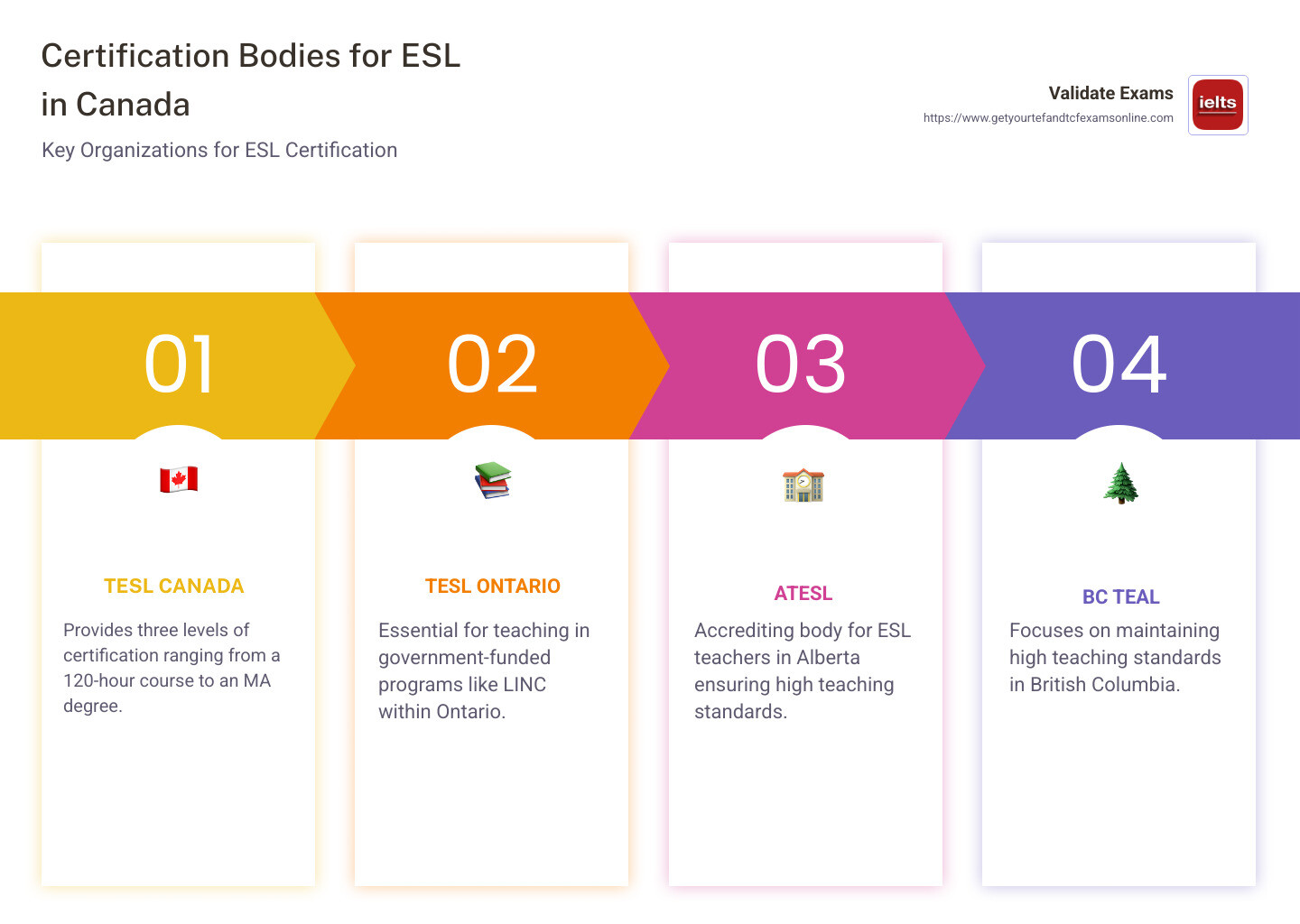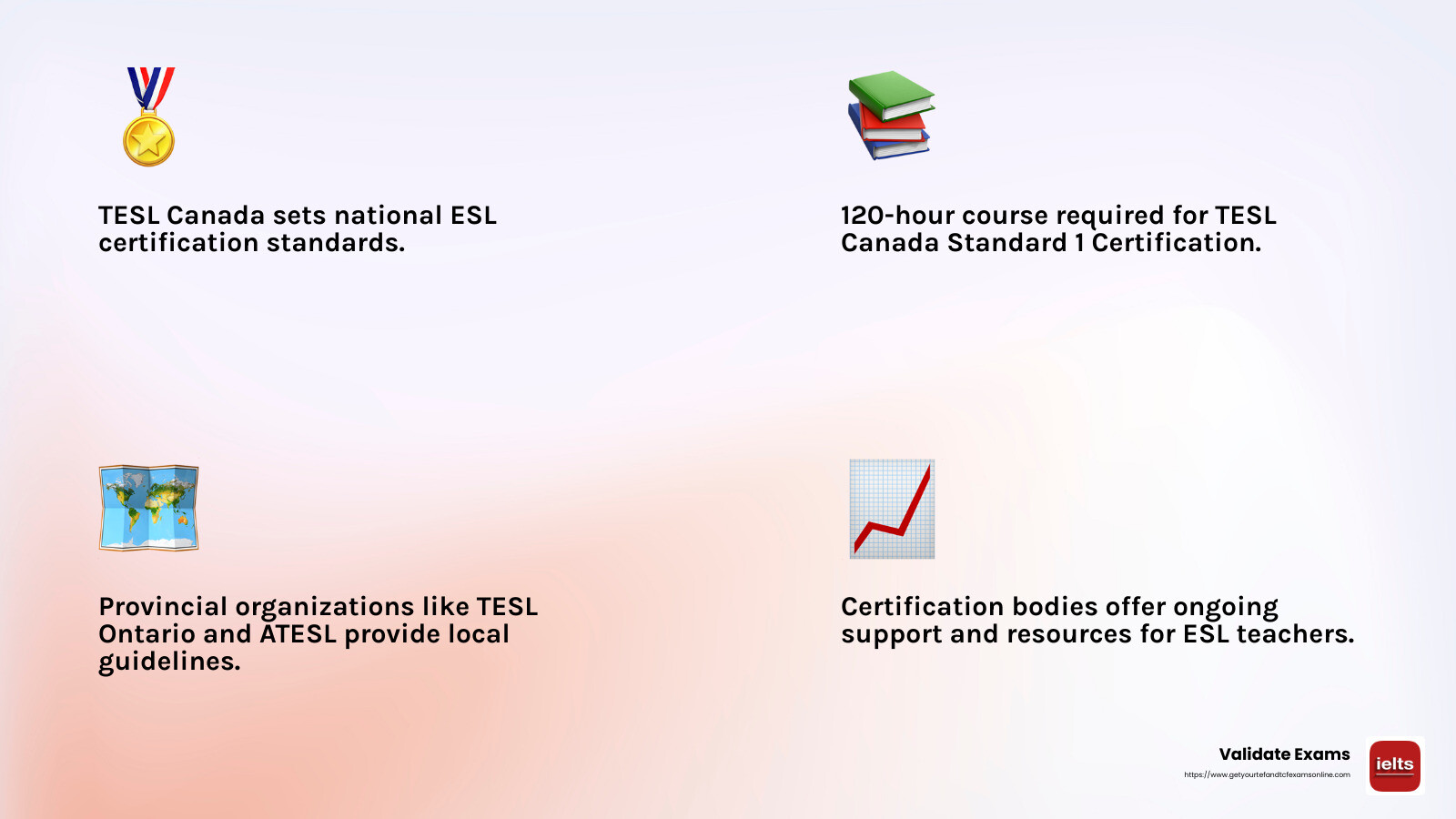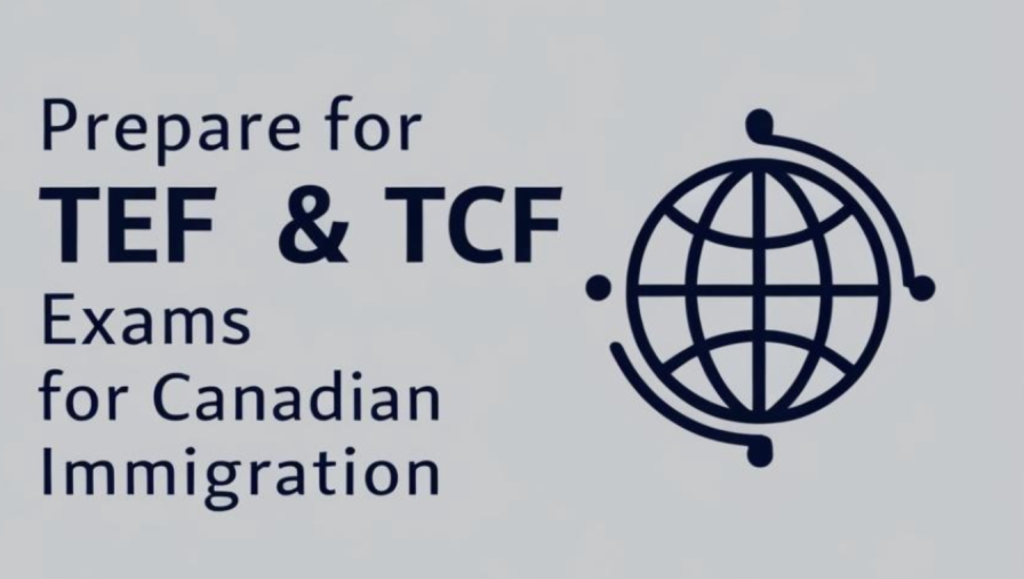English as Second Language Certification Canada: Top 5 Tips
English as second language certification canada is essential for those looking to teach English in Canada and beyond. Whether you’re aiming to teach newcomers in Ontario’s LINC program or international students in British Columbia, these certifications validate your teaching abilities and knowledge of the English language. Here’s a quick overview of what you need to know:
- TESL Canada Certification: Offers three levels of certification, with varying requirements from a 120-hour course (Standard 1) to an MA degree (Standard 3).
- TESL Ontario Certification: Essential for teaching in government-funded programs like LINC within Ontario.
- Provincial Certifications: Other provinces like Alberta and British Columbia have their own accrediting bodies, such as ATESL and BC TEAL, focusing on maintaining high teaching standards.
Now, let’s dive deeper into English teaching in Canada, starting with the fundamental certification process.
Transitioning to a proficiency in teaching English doesn’t just rely on linguistic skills alone. It demands an understanding of pedagogical practices and cultural nuances, which are integral to english as second language certification canada programs.
I’m Baddo Magical, a seasoned educator with a wealth of knowledge in language certifications like TEF, TCF, and IELTS. Through my experience with English language testing, particularly in Canada, I’ve guided many in navigating the complexities of english as second language certification canada, ensuring they find the best fit for their career aspirations.

Basic english as second language certification canada terms:
- how can i get english language certificate
- language certificate Canada
- teaching english as a second language certificate canada
Understanding ESL Certification in Canada
Obtaining English as Second Language Certification in Canada involves a structured process that adheres to national standards and provincial guidelines. This ensures that teachers are well-prepared to meet the diverse needs of learners across the country. Let’s break down the essentials.
National Standards
At the national level, TESL Canada sets the benchmark for ESL certification. This organization is the largest federation of ESL teachers and learners in Canada. They ensure that all certified teachers have met rigorous training requirements. The certification levels vary, from a 120-hour course for Standard 1 to an MA degree for Standard 3. These standards are designed to ensure teachers are equipped with the necessary skills to provide quality education.
Provincial Guidelines
Each province in Canada may have its own specific guidelines and requirements for ESL certification. For instance, TESL Ontario is crucial for those wishing to teach in Ontario’s government-funded programs like LINC. Similarly, ATESL in Alberta and BC TEAL in British Columbia provide provincial certifications that align with local educational needs and standards. These provincial bodies focus on maintaining high teaching standards and often offer additional resources and professional development opportunities for teachers.
Certification Bodies
Several organizations are responsible for certifying ESL teachers in Canada. TESL Canada is the national body, but provincial organizations like TESL Ontario, ATESL, and BC TEAL also play significant roles. These bodies not only certify teachers but also provide ongoing support through conferences, workshops, and teaching resources. They help teachers stay updated with the latest teaching methodologies and cultural insights necessary for effective language teaching.

These certification bodies ensure that ESL teachers in Canada are not only knowledgeable in language instruction but are also culturally responsive and adaptable to the needs of diverse learners. With these certifications, teachers can confidently step into various teaching roles, whether in private language schools or public programs.
By understanding these standards and guidelines, aspiring ESL teachers can steer the certification process more effectively, setting the foundation for a successful teaching career in Canada.
Next, we will explore the steps to obtaining an ESL certification, providing a clear path for those eager to start on this rewarding journey.
Steps to Obtain English as Second Language Certification in Canada
If you’re aiming for English as Second Language Certification in Canada, understanding the steps involved is crucial. Let’s walk through the key components: certification standards, approved programs, and practicum experience.
Certification Standards
To teach ESL in Canada, you must meet specific certification standards. TESL Canada sets these benchmarks, ensuring that teachers are well-prepared. Certification levels vary, with Standard 1 requiring a 120-hour course, while more advanced levels may demand higher qualifications, like a master’s degree. These standards ensure teachers are equipped with essential skills for quality education.
Approved Programs
Selecting an approved program is your next step. Programs like the Teaching Second Language Certificate offer flexible options, both online and in-person. This program, for instance, comprises 130 hours of coursework and an optional 20-hour practicum. You can complete it in one to two years, depending on your pace.
- Online and In-Class Options: Courses are available in both formats. This flexibility allows you to balance studies with other commitments.
- Course Offerings: Programs often include courses like LLED 489 and LLED 478, covering language theory and practical skills. These courses provide a solid foundation in language teaching.
Practicum Experience
A practicum is a vital part of your certification journey. It offers hands-on teaching experience, crucial for applying theoretical knowledge. For instance, the LLED 399 practicum involves 39 hours of teaching, learning, and reflection. This includes 10 hours of observation and 10 hours of teaching, providing real-world classroom experience.
- Pre-Practicum Orientation: Before you begin, a 4-hour orientation with an advisor and sponsor teacher prepares you for the practicum.
- Workshops: The practicum includes 9 hours of pre-practicum and 6 hours of post-practicum workshops. These workshops help you reflect on your teaching experiences and improve your skills.
Completing these steps will set you on the path to becoming a certified ESL teacher in Canada. Each element, from meeting certification standards to gaining practicum experience, equips you with the tools needed for a successful teaching career.
Now, let’s dig into the flexible certification programs available, offering adaptable schedules and course lengths to suit diverse needs.
Flexible Certification Programs
When pursuing English as Second Language Certification in Canada, flexibility is key. Many programs offer a variety of formats and schedules to accommodate different lifestyles and commitments.
Online and In-Person Options
One of the main advantages of ESL certification programs is their delivery format. You can choose between online and in-person courses, or even a mix of both. This flexibility allows you to tailor your learning experience to your personal and professional life.
- Online Learning: Ideal for those with busy schedules or who prefer learning from home. Online courses provide access to materials, instructors, and fellow students via digital platforms. This setup is perfect for self-paced learning.
- In-Class Learning: If you thrive in a traditional classroom environment, in-person courses offer direct interaction with instructors and peers. This format may be more structured, which can be beneficial for those who prefer scheduled learning times.
Adaptable Schedules
Programs are designed with part-time learners in mind. You can choose to take one course per term, allowing you to complete the certification at a comfortable pace. For those eager to finish quickly, some programs offer an accelerated one-month, full-time option.
- Part-Time Option: Taking one course per term typically allows you to complete the program in one to two years. This pace is manageable for those balancing work, family, or other commitments.
- Accelerated Option: Available for those who can dedicate full-time efforts, allowing completion in a shorter timeframe, such as the one-month option offered in August.
Course Length
The length of ESL certification programs can vary, but a common example is a 130-hour program. This includes core courses that cover both language theory and practical teaching skills, ensuring a comprehensive education.
- Core Courses: These include essential topics like language acquisition and classroom management, providing a strong foundation for your teaching career.
- Optional Practicum: Some programs offer a 20-hour teaching practicum, adding real-world experience to your learning journey.
Choosing the right program depends on your personal needs and career goals. With flexible options, you can find a path that suits your lifestyle and helps you achieve your certification efficiently.
Next, we’ll explore the financial aspects of ESL certification, including tuition fees and available financial aid.
Cost and Financial Assistance for Certification
When pursuing English as Second Language Certification in Canada, understanding the financial aspects is crucial. Let’s break down the costs and explore options for financial aid and scholarships.
Tuition Fees
The cost of ESL certification programs can vary widely depending on the institution and the program format. Typically, tuition fees cover:
- Course Materials: Including textbooks and access to online resources.
- Student Activity Fees: Supporting campus events and student services.
- U-Pass: A transit pass for students, available at some institutions.
For example, at Douglas College, you can use their tuition & fee estimator to get a detailed breakdown of costs.
Financial Aid
Many institutions offer financial aid options to help students manage tuition costs. Here are some common forms of aid:
- Student Loans: Government or private loans that you repay after completing your certification.
- Grants and Bursaries: Financial awards that do not require repayment, based on need or merit.
It’s important to check with your chosen institution about the availability of these options and how to apply.
Scholarships
Scholarships are another great way to help fund your ESL certification. They are typically awarded based on academic performance, community involvement, or other criteria. Here are a few tips for securing scholarships:
- Start Early: Begin your search well before your program starts to ensure you meet application deadlines.
- Research: Look for scholarships specific to ESL certification or those offered by professional organizations like TESL Canada.
- Apply Widely: Don’t limit yourself to one or two scholarships. Apply to as many as you qualify for to increase your chances.
Douglas College, for instance, offers information on funding opportunities through their Global Engagement initiative, which can be especially useful if you’re considering an international practicum.
Navigating the financial aspects of ESL certification doesn’t have to be overwhelming. With a clear understanding of tuition fees, financial aid, and scholarships, you can make informed decisions and find the support you need to achieve your certification goals.
Next, let’s dive into frequently asked questions about ESL certification to clarify common concerns and provide more insights.
Frequently Asked Questions about English as Second Language Certification in Canada
What are the requirements for ESL certification in Canada?
To pursue English as Second Language Certification in Canada, you’ll need to meet some basic requirements:
- Educational Background: Typically, you must have completed at least a bachelor’s degree. Some programs may accept students in their third or fourth year of university study.
- Language Skills: If English is not your first language, you’ll need to demonstrate proficiency. This might mean passing a test like the IELTS or TOEFL. Each program will have its own specific requirements, so check with them directly.
- Volunteer Experience: It’s often recommended to have some volunteer experience in an ESL setting. This helps you get a feel for the teaching environment and can strengthen your application.
How long does it take to complete an ESL certification program?
The length of ESL certification programs can vary:
- Standard Duration: Most programs take between one and two years to complete if you’re studying part-time. This allows flexibility for those who are working or have other commitments.
- Full-Time Options: If you can study full-time, you might finish faster. Some programs offer accelerated pathways that can be completed in as little as a few months.
- Flexible Scheduling: Many institutions offer online or hybrid courses, so you can balance your studies with other responsibilities.
Can I teach English in public schools with ESL certification?
Teaching in Canadian public schools requires more than just ESL certification:
- Teaching License: In addition to your ESL certification, you’ll need a teaching license. For example, in Ontario, you must attend the Ontario College of Teachers to get licensed.
- Additional Qualifications: Each province may have different requirements. You might need to meet certain provincial guidelines or complete additional coursework.
- Public School Eligibility: ESL certification is more commonly used for teaching in private language schools or programs like LINC, which focuses on aiding immigrants and refugees.
While ESL certification is a great start, ensure you understand the additional steps required to qualify for teaching positions in public schools.
Conclusion
Navigating the path to English as Second Language Certification in Canada can seem daunting, but it doesn’t have to be. At Validate Exams, we offer a unique solution that makes the certification process stress-free and straightforward.
Why Choose Validate Exams?
Our approach is simple and efficient. We provide genuine and verifiable language proficiency certificates without the need for traditional exams. This means you can avoid the stress and uncertainty that often accompany exam preparations and retakes.
Here’s why our service stands out:
- Stress-Free Certification: With us, you bypass the usual exam pressures. No need to worry about exam dates, preparation, or potential failure. We handle the process, so you can focus on your teaching goals.
- Guaranteed Success: We ensure that you receive the scores you need, allowing you to pursue your teaching career without delay. Our certificates are officially registered and can be verified with the issuing institutions, giving you peace of mind.
- Fast and Reliable: Our service is designed to be quick and efficient. You receive your certificate in the shortest time possible, so you can start teaching sooner.
For more information on how we can assist you in obtaining your certification, visit our Understanding Language Certificates page.
By choosing Validate Exams, you’re opting for a hassle-free path to achieving your teaching aspirations. Whether you’re aiming to teach in private language schools or programs like LINC, our certification process is custom to help you succeed.

